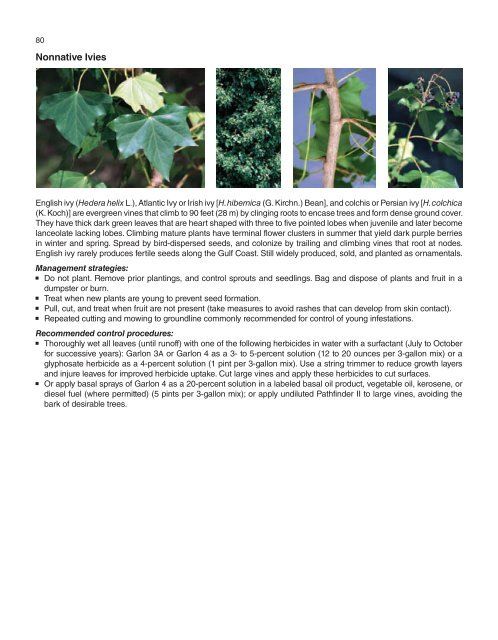A Management Guide for Invasive Plants in Southern Forests James ...
A Management Guide for Invasive Plants in Southern Forests James ...
A Management Guide for Invasive Plants in Southern Forests James ...
- No tags were found...
Create successful ePaper yourself
Turn your PDF publications into a flip-book with our unique Google optimized e-Paper software.
80Nonnative IviesEnglish ivy (Hedera helix L.), Atlantic Ivy or Irish ivy [H. hibernica (G. Kirchn.) Bean], and colchis or Persian ivy [H. colchica(K. Koch)] are evergreen v<strong>in</strong>es that climb to 90 feet (28 m) by cl<strong>in</strong>g<strong>in</strong>g roots to encase trees and <strong>for</strong>m dense ground cover.They have thick dark green leaves that are heart shaped with three to five po<strong>in</strong>ted lobes when juvenile and later becomelanceolate lack<strong>in</strong>g lobes. Climb<strong>in</strong>g mature plants have term<strong>in</strong>al flower clusters <strong>in</strong> summer that yield dark purple berries<strong>in</strong> w<strong>in</strong>ter and spr<strong>in</strong>g. Spread by bird-dispersed seeds, and colonize by trail<strong>in</strong>g and climb<strong>in</strong>g v<strong>in</strong>es that root at nodes.English ivy rarely produces fertile seeds along the Gulf Coast. Still widely produced, sold, and planted as ornamentals.<strong>Management</strong> strategies:Do not plant. Remove prior plant<strong>in</strong>gs, and control sprouts and seedl<strong>in</strong>gs. Bag and dispose of plants and fruit <strong>in</strong> adumpster or burn.Treat when new plants are young to prevent seed <strong>for</strong>mation.Pull, cut, and treat when fruit are not present (take measures to avoid rashes that can develop from sk<strong>in</strong> contact).Repeated cutt<strong>in</strong>g and mow<strong>in</strong>g to groundl<strong>in</strong>e commonly recommended <strong>for</strong> control of young <strong>in</strong>festations.Recommended control procedures:Thoroughly wet all leaves (until runoff) with one of the follow<strong>in</strong>g herbicides <strong>in</strong> water with a surfactant (July to October<strong>for</strong> successive years): Garlon 3A or Garlon 4 as a 3- to 5-percent solution (12 to 20 ounces per 3-gallon mix) or aglyphosate herbicide as a 4-percent solution (1 p<strong>in</strong>t per 3-gallon mix). Use a str<strong>in</strong>g trimmer to reduce growth layersand <strong>in</strong>jure leaves <strong>for</strong> improved herbicide uptake. Cut large v<strong>in</strong>es and apply these herbicides to cut surfaces.Or apply basal sprays of Garlon 4 as a 20-percent solution <strong>in</strong> a labeled basal oil product, vegetable oil, kerosene, ordiesel fuel (where permitted) (5 p<strong>in</strong>ts per 3-gallon mix); or apply undiluted Pathf<strong>in</strong>der II to large v<strong>in</strong>es, avoid<strong>in</strong>g thebark of desirable trees.
















